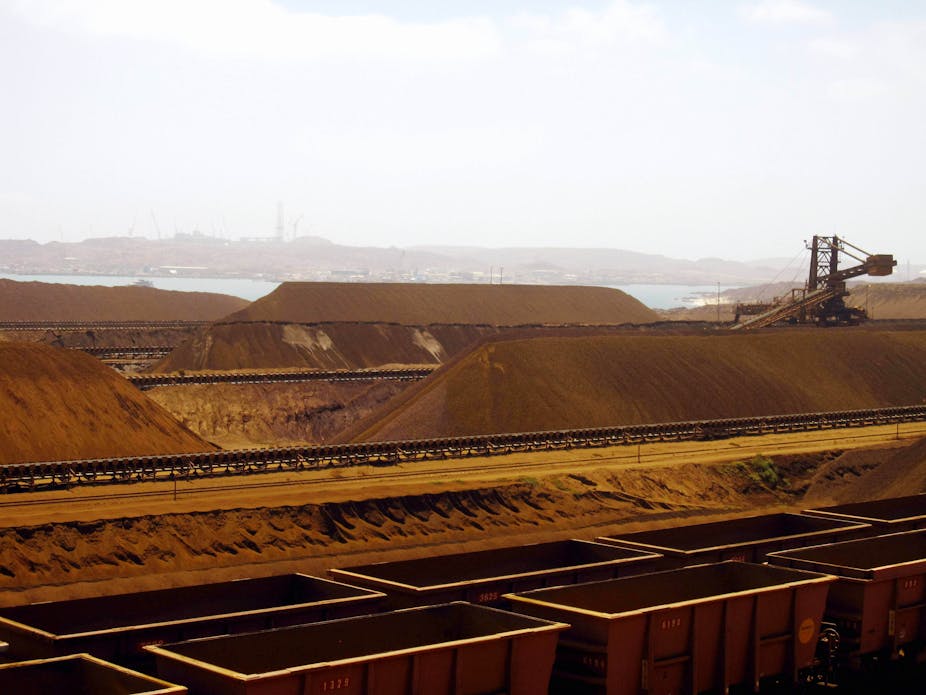The International Monetary Fund recently called on Australia to bank more of the proceeds of the resources boom.
The fund has warned that Australia needs to manage its resources wisely, or run the risk of having falls in commodity prices damage the economy.
This concern should be shared by Australian policymakers.
Despite high prices for mineral commodities in recent years, Australia rarely earns as much from its exports as it spends on imported goods and raw materials.
The question of whether we are thinking hard enough about the long-term benefit from Australia’s mineral income has also been a “hot” topic.
Some of the talk has been about heavy public investments in supporting the minerals industry, and the impact that this focus has on other sectors of the economy.
Another concern is that while prices for coal exports are currently high, prices for products used by mining, and other industries, are also going up.
In the years ahead it is once again likely that we will spend more on petrol imports than we get for our coal exports. This is a situation that will only get worse as we produce less of our own supplies.
It has been estimated that we will be importing 60% of our petrol needs by 2015.
Shifting sands
Australia relies heavily on exports of coal and iron ore for its international purchasing power.
However, Australia’s mineral resources are being extracted at increasing rates to meet global demand while high-quality and easily accessible resources are not being discovered at the same rates.
Australia’s position as a major exporter of bulk commodities faces very large challenges in the years ahead.
Other countries are expanding their mineral exports and this will bring down prices.
At the same time, there may be a downturn in demand. For example, in its latest five-year plan (2011-2015), China seems to be changing its focus from producing large amounts of goods to looking at the quality of what it produces.
Australian mining also faces productivity challenges, identified by the Australian Productivity Commission. This is partly a result of lower quality ores together with increasing mine size, waste, pollution, and energy intensity.
Importantly, investment in mining takes up to five years to make an impact on production rates. This has also played a part in reducing the industry’s productivity since the beginning of the first of Australia’s mining booms.
A taxing debate – sovereign risk or sovereign wealth?
A large decline in the comparative advantage of mining in Australia shines a light on what we’ve already gained from mineral resource exports, and the need to make the most of this “wealth” while prices are still high.
Accepting the possibility that comparative advantage may have already been lost, or will be lost in the near future, will help the nation and the sector to focus on innovation and alternatives.
The resource super profits tax (RSPT), recommended in the Henry Tax Review, tried to address the fact that the existing royalties system does not give the community a benefit from the high prices that are providing profits to mining companies.
Debate about the RSPT, and now the modified mineral resource rent tax, has been messy and there has been little discussion on how the money from the tax would be used.
One approach that has been discussed more recently, has been the introduction of a sovereign wealth fund (SWF).
One or more SWFs could be created in a way that would stabilise the Australian dollar. This would help other export sectors to remain competitive. This fund could also be used to invest in new and sustainable economic development and infrastructure.
It is important to improve our management of the benefits of mining, but it is also important to improve the social and environmental performance of the mining industry. We also need to think beyond digging holes in the ground as a basis for our future prosperity as a nation.
One example of this might be selling our mining know-how, equipment, and software. Australian mining software is now a multi-billion dollar export – more than the combined value our uranium and zinc exports.
Looking to the future – Australia’s minerals in 2040
As well as thinking of better things to do with the money we gain from mining, we should also look at ways to use metals more sustainably. Australian resources companies should be encouraged to follow the example of the Responsible Jewellery Council, whose members promote ethical social and environmental practices from gold mines to retail outlets.
What can we do to ensure that there will come a time when “brand Australia” minerals are chosen because they have high social and environmental standards?
In 2040, imagine walking into a shop where your environmentally friendly mobile phone is manufactured on the spot in a 3D printer using a cartridge of Australian metals – leased and then collected for recycling.
Such innovations would mean we can make money not only from digging them out of the ground, but at most points along the production chain.
These opportunities and innovations need to be positioned within a broader strategy for mining in Australia in the decades ahead.
The Institute for Sustainable Futures at UTS is seeking input to a leading a national conversation on mining in Australia to 2040 as part of the CSIRO Mineral Futures Collaboration Cluster. See http://resourcefutures.net.au/ to download the draft vision and contribute your views to the strategy.
How can mining be not only sustainable, but proactively contribute to a sustainable Australia? Comment below.
Related coverage:
It’s the structural deficit, stupid

